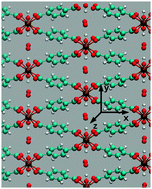Investigation of structure and dynamics of the hydrated metal–organic framework MIL-53(Cr) using first-principles molecular dynamics
Abstract
The hydration behavior of metal–organic frameworks (MOFs) is of interest both from a practical and from a fundamental point of view: it is linked, on the one hand, to the hydrothermal stability (or instability) of the nanoporous material, which might limit its use in technological applications. On the other hand, it sheds light on the behavior of water in a strongly confined environment. Here, we use first-principles molecular dynamics (MD) to investigate two hydrated phases of the flexible MOF MIL-53(Cr), which adopts a narrow- or a large-pore form, depending on the water loading. Structure and dynamics of the two phases are thoroughly analyzed and compared, with a focus on the hydroxyl group of MIL-53(Cr) and the water molecules in the nanopores. Furthermore, the behavior of the confined water is compared to that of bulk water. Whereas in the narrow-pore form, water is adsorbed at specific crystalline sites, it shows a more disordered, bulk-like structure in the large-pore form. However, reorientation dynamics of water molecules in the latter is considerably slowed down with respect to bulk water, which highlights the confinement effect of the nanoporous framework.


 Please wait while we load your content...
Please wait while we load your content...